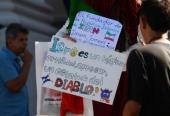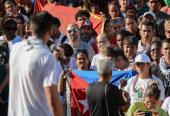Cuba is teaching the world lessons in sustainability

Along with the realization that climate change will affect the planet through rising sea levels, flooding, fires, droughts, hurricanes, tornadoes and irregular wind patterns also comes the realization that food security will need to be a priority. Innovative models of agriculture will need to be practiced for other reasons as well.
The sudden coronavirus pandemic alert is another strong reminder that food security and sustainability help create a more resilient society all round. For now, Canadians are largely worried about limiting the spread of the virus, or getting home safely from other countries. As days of isolation turn into weeks, remote work or unemployment becomes a reality for most, and spring arrives, we may soon wonder why we have not turned our back- and front-yards into food gardens sooner.
There is at least one country in the world which is showing the way in terms of both food security and sustainability, and, if we are wise, we will put in place policies that follow its lead.
That country is Cuba -- recently named the most sustainably developed country in the world.
A few months ago, the "Sustainable Development Report" was launched. This innovative report ranks the countries of the world based on their carbon footprint. It uses various indicators to underscore how sustainable a society is given its CO2 emissions and material footprint.
The sustainable development index (SDI) was created to chart each country's development in terms of ecological impact. The human development index (HDI), which is the indicator that many countries and organizations have used for decades to map development, does not take into account environmental indicators. The top performers in the HDI are countries which contribute the most in CO2 emissions and material footprint. The HDI actually lauds and encourages these so-called "top performers," while shamelessly ignoring their destructive impact on the planet.
For that reason, the SDI was created. It takes into account our contributions to climate change, and in so doing, some would say it more accurately charts development and sustainability. The SDI measures the ecological efficiency of a country in delivering development. To create the SDI, typical human development indicators are measured (life expectancy, education, income etc.) and divided by ecological factors, such as a country's CO2 emissions and its per capita material footprint.
The sustainable development index promotes a new vision, one compatible with the ecology of our planet.
And so while Canada and the U.S. would be near the top of the human development index, when it comes to the sustainable development index, both countries are much closer to the very bottom of the scale of the 163 countries. Canada places 158th on the SDI, just below Norway, and just above the U.S., which places 159th. And, at the very top of the SDI scale -- yes, number one -- is Cuba. Second is Costa Rica.
I find it amazing that a country such as Cuba -- which has gone through so many trials, special periods and almost six decades of a U.S. embargo -- is leading the world on a sustainability index. Yet, it is those very trials that have impacted greatly how the country respects its environment. It shows that countries like Canada, and other so-called "developed" nations, have much to learn.
One of the factors in reduced carbon emissions in Cuba is its current model of agriculture. We know from previous columns published here that Canadian agriculture has a heavy carbon footprint because of petrochemical based inputs and our industrialized model of agriculture, contributing at least 12 per cent to national emissions.
Meanwhile, Cuba's food system has taken exactly the opposite direction. That direction was forced on Cuba beginning in 1989 with the fall of the Soviet Union. Almost overnight, Cuba lost 80 per cent of its imports. Food, as well as petroleum, fertilizers, pesticides and much more, disappeared. Cuba was left almost completely exposed to the United States embargo. There was no gas to run the tractors, no fertilizers or pesticides for the crops. Cuba found itself with a huge food security problem.
While food was grown in the countryside, trucks that transported food crops to the city ran out of fuel. As well, much of the land was still dedicated to sugar cane, which was heavily traded with the Soviet Union for other food goods. According to figures from the United Nations Food and Agriculture Organization, Cubans, accustomed to eating around 2,600 calories a day, suddenly were eating between 1000 and 1500 calories a day. The Cuban people and the government had to move quickly. People were hungry.
Cubans were caught needing to improvise and plan. Cuban agriculture experts began to encourage and support a system of small organic urban farms and gardens in cities such as Havana. People learned how to build soil systems, compost and tend food crops. Empty city lots began to be filled with raised beds of topsoil, local people were trained in how to grow food, cultivation strategies and how to rejuvenate and prepare city soil for seeding. Cuban city dwellers -- people who had never grown anything ever -- became farmers and gardeners.
During a recent visit to Havana, I visited a few large urban gardens. A few short blocks from my room in Havana's Miramar district, and along La Quinta (as Havana's 5th avenue is called), I visited one of the city's oldest urban gardens, established in 1994 at the height of the Special Period. This garden was the second to be created in Havana and stretches over a full city block
Havana alone has more than 318 intensive urban gardens. These days urban farms supply 70 per cent or more of all the fresh vegetables consumed in cities such as Havana and Villa Clara.
The urban garden model is so successful that Cuba's system of organic urban gardens is being touted as the model to follow as we seek resilience in food production, given the vagaries of climate change, and yes embargoes, and perhaps even viruses and closed borders.
During my recent trip to Cuba, I was surprised at how smoothly the economy seemed to be running despite the past year of difficulties created by Trump and his administration's application of severe sanctions under the Helms-Burton Act.
In January and February, I saw plentiful markets and vendors with carrots, peppers, oranges, lettuces, onions and many other fruits and vegetables. Stores had eggs, chicken and other necessities. Potatoes were in short supply (out of season), and beef is always difficult to find. But these days 90 per cent of all fruits and vegetables consumed in Cuba are grown in Cuba.
My recent visits to the lush organic gardens of Havana were an eyeopener.
It is true that that there are shortages of fuel in Cuba given that many barges are unable or unwilling to deliver oil to Cuba because of Trump's sanctions.
In mid-2019, the U.S. banned cruise ships from entering the port of Havana. And, just a few weeks ago, the Helms-Burton laws were applied to Western Union. It is now prohibited from transferring funds to Cuba from all countries (except the U.S. where Miami-based Cuban-Americans will soon vote in the 2020 election). Remittances are a large part of the Cuban economy, so these measures are creating hardship.
But these days the Cuban economy and its people are once again showing resilience. Measures are underway to use less energy; more electric vehicles are being purchased from China; and Cubans with private or public vehicles are once again being asked to give rides to those waiting in the streets for buses.
There is a shortage of fuel in Cuba. But one thing is sure: the days of the Special Period and of eating half the recommended daily caloric intake for men and women will likely not return to Cuba. Cuba is much more self-sufficient these days when it comes to food, and it now produces more than half of all of the food that Islanders consume.
Despite the U.S. embargo, Trump's application of the most severe clauses of Helms-Burton and the loss of the Soviet Union more than three decades ago there is increased resilience in Cuba.
And when a country can feed its citizens, it can make room to help others.
That is exactly what Cuba is doing.
As I write, the Cuban government has accepted the request that a British cruise ship dock in Havana so that humanitarian aid can be provided to passengers who have COVID-19. The ship was refused entry by several Caribbean nations -- but the Cuban government accepted the request.
As well, Cuban doctors have landed in Italy to provide assistance to that country's overwhelmed medical system
Climate change, sustainability, viruses, cruise ships -- the Cubans are showing amazing strength and plenty of lessons to learn about tough times, gardening and humanitarianism.
And it really all starts with food security.














Add new comment